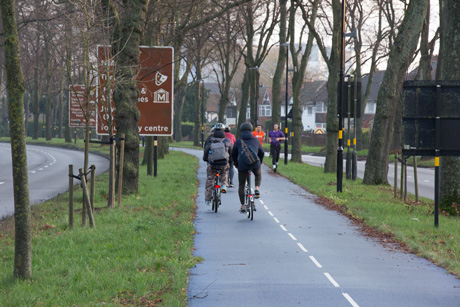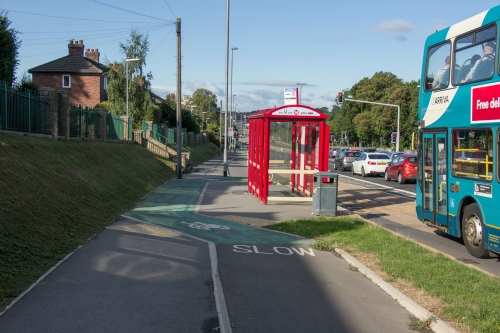Gear Change vision for cycling and walking
28th July 2020

The government's plans to boost walking and cycling are announced today. Gear Change, A Bold Vision for cycling and walking, was published last night. There are also new principles for cycle infrastructure design, and a consultation on changes to the Highway Code.
Government press release
The government's press release today is headed 'PM kickstarts £2bn cycling and walking revolution'.
The main themes of the press release are:
- new protected bike lanes
- cycle training for everyone (adults and children) who wants it
- bikes available on prescription
The thinking is that we should tackle the causes of ill health, not just the symptoms, and cycling benefits physical and mental health. The plans announced aim to build on the increase in cycling during the pandemic. It is intended to be a comprehensive, long-term vision to increase active travel.
Boris Johnson is quoted as follows:
"From helping people to get fit and healthy and lowering risk of illness, to improving air quality and cutting congestion, cycling and walking have a huge role to play in tackling some of the biggest health and environmental challenges we face."
Grant Shapps said:
"We've got a once in a lifetime opportunity to create a shift in attitudes for generations to come, and get more people choosing to cycle or walk as part of their daily routine."
The funding available is still the same £2bn already announced in May, but the press release does add that there's to be a long-term cycling programme and budget.
Standards for cycling infrastructure are to be improved through updated guidance published today. The press release states:
"...higher standards will make clear that schemes which consist mainly of paint, which makes pedestrians and cyclists share the same space, or which do not make meaningful changes to the status quo on the road, will not be funded. These standards will be overseen by a new inspectorate, Active Travel England, which will be responsible for the cycling budget and help make sure schemes are compliant with the new standards."
Bike repair vouchers worth £50 will be released, starting with a batch of 50,000 just before midnight tonight (Tuesday 28th July).
Gear Change, A bold vision for cycling and walking
Gear Change is a 52-page document that sets out the details of today's announcement.
Foreword
A foreword by Boris Johnson notes that, 'Vast numbers of car journeys are very short and could easily be travelled by bicycle. People often think that encouraging bikes and walking causes congestion - but it doesn't...'
Johnson notes that in the light of the pandemic, we need to make lifestyle changes to keep us more active and fit, and how we travel is central to that.
Finally, he comments on opposition to building bike lanes in London, and points out that '...when the results of consultations and opinion polls came back, our opponents were often surprised to find themselves in a small minority.'
Introduction: A case for Step Change
The Introduction sets out some of the benefits of increased active travel, and challenges it can help tackle: air quality, climate change, health and well-being, inequalities, and congestion.
A Bold Vision for a New Era
The vision is to make cycling and walking the natural first choice for many journeys. That's the same as the vision in the Cycling and Walking Investment Strategy, which has yet to result in any real change. Now there's a target of half of all journeys in towns and cities being cycled or walked by 2030.
Better cycling and walking infrastructure is to be at the heart of transport policy and planning, and this is to lead to healthier, happier and greener communities, and safer streets.
Gear Change stresses action, not just words - and that has to be right, because we've had the words before but no action. The plan is to encourage and empower local authorities to take bold decisions. The themes that follow set out the action needed.
Theme 1: Better streets for cycling and people
This section talks about first hundreds, then thousands, of safe, continuous, direct routes for cycling in towns and cities, physically separated from pedestrians and volume motor traffic. Key points include:
- Cycle lanes must be physically separated from traffic. 'New cycle route provision on busy roads which consists of painted markings or cycle symbols will no longer be funded. We want to see as many as possible of the existing painted lanes upgraded with physical separation.'
- Cycles must be treated as vehicles, not as pedestrians. 'New cycle provision which involves sharing space with pedestrians, including at crossings, will no longer be funded.'
- Routes must be direct and continuous, not giving up at the difficult places. 'If it is necessary to reallocate roadspace from parking or motoring to achieve this, it should be done'.
- Point closures are to be encouraged - for example using retractable bollards. Traffic can still reach places on the road, but it is closed to through traffic.
- Point closures will also be used to close residential streets to rat-running and create Low Traffic Neighbourhoods. There's to be a consultation on a right for residents to petition local authorities for rat-run closures.
- Create more School Streets, and give local authorities powers to enforce them.
- Create more mini-Hollands; 12 non-London local authority areas will be chosen.
- At least one small or medium-sized zero-emission city, with extensive bike lanes, an all-electric bus fleet, and a ban on nearly all petrol or diesel vehicles in the city centre.
- Improve the National Cycle Network to make it more useful for everyday journeys (less leisure-focused), and up the quality - including removing barriers and providing smooth, all-weather surfacing
Cycle Infrastructure Design

There's new Cycle Infrastructure Design for England and Northern Ireland. A summary of 22 points is in the Appendix to Gear Change, and the full 188-page guidance is in Local Transport Note 1/20.
Read more about the new Cycle Infrastructure Design.
Theme 2: Putting cycling and walking at the heart of transport, place-making and health policy
Theme 2 contains a number of principles designed to ensure that cycling is at the heart of policy. They include:
- Creating a long-term cycling and walking programme and budget
- A presumption that in any local highways investment, cycling infrastructure will be delivered to the new standards; Highways England are also supposed to build some cycling infrastructure but I doubt anything useful will come out of that
- The DfT's cost-benefit analysis tools will be reviewed to make sure they properly value cycling schemes
- Investing in cycle routes to stations, adding cycle parking at stations, and increasing spaces for bikes on trains
- Allow bikes on some buses
- Install secure cycle parking in town and city centres, at hospitals and schools, and in residential areas
- Ensure that new housing and business developments are built around making sustainable travel the first choice for journeys - not just in theory, but in practice too; Active Travel England will be a statutory consultee in the planing system
- Conduct national urban road audits to inform future allocation of road space
- Extend the e-cargo bike grant programme and encourage freight by electric bike
Theme 3: Empowering and encouraging local authorities
Local authorities own all roads except motorways and trunk roads. They need to be helped to improve conditions for cycling on their roads. Measures include:
- Active Travel England will hold the cycling budget, and have an extensive role in promoting best practice, advising local authorities and training staff
- giving powers to local authorities under the Traffic Management Act 2004 to enforce moving traffic offences like entering mandatory cycle lanes. (I won't hold my breath on this one)
- Funding only schemes that meet the new standards in Theme 1 and the Appendix of Gear Change. (This includes Transforming Cities money)
- All future funding to be conditional on starting and finishing work by specified dates
- Active Travel England to inspect and grade Highways Authorities on their active travel performance - a bit like Ofsted - starting next year; the assessment will influence how much funding a council receives for other forms of transport
Theme 4: We will enable people to cycle and protect them when they cycle
Points under this heading include:
- Cycle training for adults and children, free or at a nominal charge
- GPs to prescribe cycling, starting with pilots in places with poor health and low physical activity; these places are to be major locations for segregated bike lanes and other infrastructure
- Do more to combat bike theft, including consolidating existing ownership registers
- Making legal changes to protect vulnerable road users, including introducing the offence of causing serious injury by careless or inconsiderate driving
- Updates to the Highway Code, to include a Hierarchy of Road Users - the principle that those road users who can do the most harm have the greatest responsibility to reduce the danger they cause
- Better vision standards for lorries
- Establish a national e-bike support programme
Appendix
The Appendix is a summary of principles for cycle infrastructure design, with 22 points to it. I think it's worth a separate web page - not least because it will then be a handy, self-contained resource to refer to in future.
Highway
Code consultation

Proposed changes to the Highway Code include a Hierarchy of Road Users, so those who can do the greatest harm have the greatest responsibility. Important suggested amendments include:
- drivers turning into or out of side streets should give way to pedestrians crossing or waiting to cross
- cyclists can ride next to each other, but should single out if drivers wish to overtake and it's safe
- it is specifically stated that cyclists should ride away from parked cars to avoid being doored
- situations where primary position is recommended include on quiet streets, and at the approach to junctions and road narrowings
- passing distances when overtaking cyclists are specified
Read more about the the Highway Code Consultation.
Spending on active travel vs new roads
The announcement today is undoubtedly good news, and there are any number of positive changes in there. Still, a huge contradiction remains.
The government is spending £2bn on active travel, but has committed to spending £28bn on new roads. That is £2bn on measures that improve health and quality of life, and 14x that amount on more destruction of the natural environment, more traffic, more pollution, and more ill health. The idea that quality bike lanes will form part of new road schemes only partly mitigates the damage of such a huge, high-carbon splurge.
The thinking behind this active travel announcement is coherent and logical, but the government should implement this good policy without destroying the benefits 14 times over.